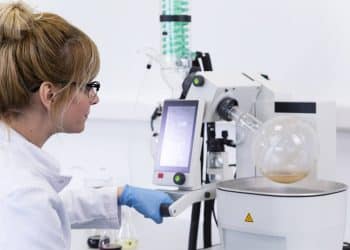By Edward G. Franklin and Melissa Wilcox, Regis Technologies, Inc.
In recent years, there has been growing interest in the development of therapies and other consumer products derived from cannabis and hemp, including cannabidiol (CBD). With the passage of the US 2018 Farm Bill, hemp was removed from the Controlled Substances Act (CSA), which means that cannabis plants and derivatives that contain no more than 0.3% total tetrahydrocannabinol (THC) on a dry weight basis are no longer controlled substances under federal law. The small amount of THC found naturally in hemp can exceed the legal limit of 0.3% when extracted and concentrated along with CBD. Therefore, it is important to have a means of removing THC from CBD extracts in order to comply with Federal regulations.
Chromatography has been used successfully in many industries as a means for purifying compounds. Supercritical fluid chromatography (SFC) is a form of normal phase chromatography that uses a supercritical fluid such as carbon dioxide as the mobile phase. SFC excels at separating and purifying compounds derived from natural sources because it is faster, uses much less solvent, and, overall, is a less expensive and greener method compared to high pressure liquid chromatography (HPLC).
We looked at the ability to separate Δ9-THC and CBD using SFC and a 4-ethylpyridine (4EP) column from Regis Technologies, Inc. Our results are shown in Figure 1, and, as you can see, it is possible to switch the elution orders of Δ9-THC and CBD simply by changing the amount of methanol modifier in the mobile phase.
Figure 1 – Overlaid chromatograms of Δ9-THC and CBD on a 4EP column. 25 cm x 4.6 mm, 5 µm; Temp = 30°C; Pressure = 150 bar
When scaling to a preparative separation, several factors should be kept in mind, including sample solubility, elution order, selectivity, resolution, mobile phase composition, and the nature of the adsorption isotherms (i.e. the peak shapes of overloaded components). Consider a case where the minor Δ9-THC peak elutes after CBD. If CBD is overloaded to the point where the peak “tails” into the later eluting, minor component, the purity and/or the yield of Δ9-THC will be compromised should its collection be desired. For this reason, it may be desirable to have the minor component elute first, where it will be relatively unaffected by the tail of a later-eluting overloaded peak. This can be achieved with the 4EP column and 90/10 CO2/MeOH.
While methanol is perhaps the most common co-solvent employed in SFC, it is an environmental pollutant and more toxic than other alcohols. In cases where purified extract will be used in the food industry, ethanol may be the preferred co-solvent. Ethanol can be used in place of methanol to achieve the same baseline resolution and elution order shown in Figure 1(b). A loading study with Δ9-THC and CBD using ethanol in the mobile phase is shown in Figure 2. Baseline resolution is maintained even with higher mass loads of CBD.
Figure 2 – SFC overlays of 0.25 µg of Δ9-THC and 0.25 – 16.5 µg of CBD on 4EP. 25 cm x 4.6 mm, 5 µm; Flow = 3.0 mL/min; (90/10) CO2/EtOH; Temp = 30°C; Pressure = 150 bar. The “tail” of CBD peak will not compromise the peak purity of a collected Δ9-THC peak.
In summary, 4EP can be used for the SFC separation and purification of CBD from extract containing THC. 4EP gives good resolution along with the ability to switch the elution orders of the compounds by simply changing the mobile phase composition, allowing for versatility in the optimization of a preparative-scale purification.














